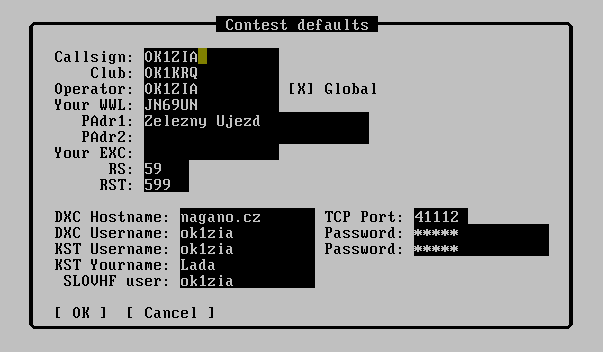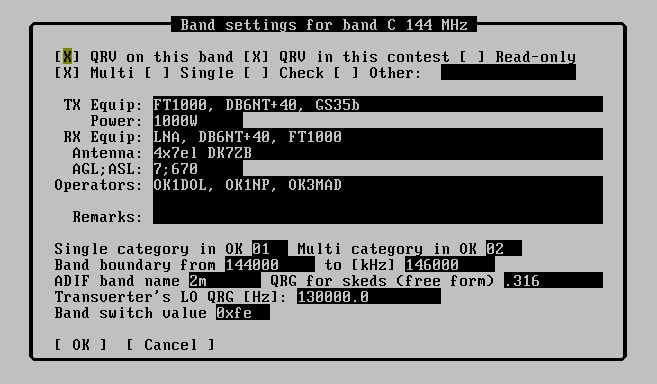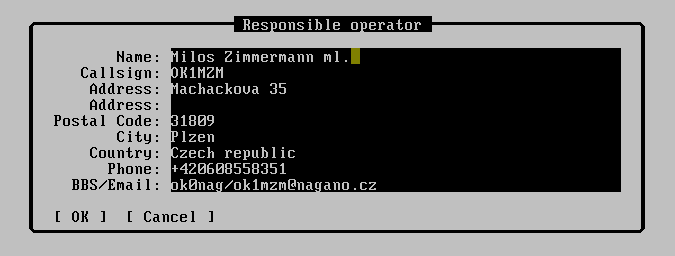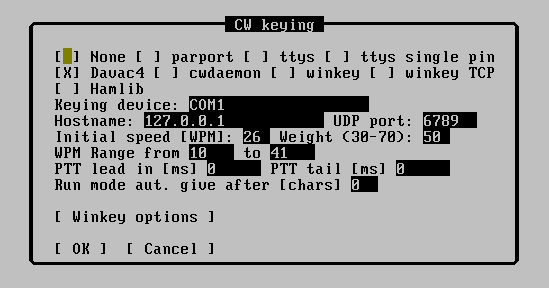FR Setup
Tous les changements dans la configuration sont gardés en mémoire jusqu'à ce que vous sauvegardiez la configuration.
Contest defaults

Il est possible de définir ces paramètres dans ce menu : inficatif pour le contest, indicatif de club (à n'utiliser que si vous pouvez exporter le log en format EDI), locator (6 caractères), QTH pour le contest (équivaut aux éléments PAdr1 et PAdr2 dans un fichier EDIThere is possible to set these items in this menu: callsign in contest, club callsign (use only if you can export contest log in EDI format), locator (6 characters), contest QTH (is equal items PAdr1 and PAdr2 in EDI), Optional Exchange ??? et les reports standards proposés pour la SSB et la CW.
Band defaults

Ce sous-menu contient les paramètres pour les bandes. Les bandes actives (pour lesquelles la case à cocher QRV est cochée) sont séparées des autres bandes. Vous pouvez ôter les bandes jamais utilisées (comme par exemple le 220 MHz en Europe).
Vous pouvez entrer dans les paramètres d'une bande (chaque bande se paramètre individuellement) en pressant la touche ENTREE. L'élément `QRV on this band' (= "actif sur cette bande") est habituellement sélectionné pour les bandes où il vous est permis d'émettre.
Ce paramètre est le seul qui doit absolument être saisi. Vous pouvez toujours paramétrer les autres éléments mais ce n'est pas obligatoire.
Le paramètre "QRV in this contest" n'a pas d'effet particulier dans ce formulaire. Vous avez le choix entre 3 catégories : Multi/Single/Check.
Les descriptions des équipements de la station doivent être insérés dans les champs TX et RX Equip. La puissance doit être écrite avec l'unité de puissance. ASL signifie la hauteur de l'antenne par rapport au niveau de la mer et AGL signifie la hauteur de l'antenne par rapport au sol. Les valeurs à insérer sont en mètres et séparées par un point-virgule.
Saisissez les indicatifs des opérateurs dans le champ Operators en les séparant d'un point-virgule. Le champ Remark est destiné à donner des remarques au correcteur du contest.
Responsible operator

Dans cette boîte de dialogue, vous saisissez toutes les informations concernant l'opérateur responsable pour tout besoin de communication avec le correcteur du concours. Vous pouvez saisir librement tous ces champs et ils ne nécessitent pas de commentaire.
CW daemon

Since 2.0 Tucnak does not use for keying and transmitting CW external program cwdaemon. It's functions are added in Tucnak.
Keying methods are:
- None - no CW output is used
- lp - uses kernel module ppdev for keying. Recommended device is http://ok1zia.nagano.cz/web/davac3. Pin configuration is:
- 1 STROBE - grounded when active.
- 14 AUTOLF - switch TRX modulation input to microphone or soundcard output
- 16 INIT - PTT
- 17 SELECT IN - CW
- ttys - uses control pins of serial port. Pinout for D-SUB9:
- 4 DTR - CW
- 5 GND - ground
- 7 RTS - PTT
- cwdaemon - not implemented yet
- N/A - reserved
Keying device f.e. /dev/parport0, /dev/ttyS0, /dev/ttyUSB0
Hostname, UDP port are reserved.
Initial speed says keying speed in WPM after program start. You can change it using PageUp or PageDown keys.
Weighting - changes ratio of mark and space in CW.
Use speaker - beeps using program soundwrapper.
SSB daemon

Since 2.0 Tucnak takes also SSB functionality for CQs and traffic recording.
Common options
Alsa, OSS, SSBD are supported "audio drivers".
Record traffic switches on/off recording band activity on receiving. If this option isn't active then all next options are irrelevant. To prevent consuming of all free space, use options Max. record duration and Minimal disk free space.
Record format option describe coding of output file. Supported options are.
- PCM 8 and 16 bits
- Logarithmic PCM u-law and A-law
- IMA and MS adaptation PCM
- GSM version 6.10 (preferred for me)
PCM coding is suitable for conversion to other formats (MP3, Ogg). GSM coding has low size. One minute of recording have size about 130 kB of disk space. That is less then 200 MB for 24 hours. This coding doesn't have to supported by your favourite player! GSM format replay for example mplayer (with codec) or sndfile-play distributed with libsndfile.
Option Channels sets number of sound channels. Set it to 1 (mono). You can set it to 2 or 4 it depends on your sound card capability.
Sample rate sets the number of sample per second. `CD' quality has value 44100. This value is needless for radio activity. It's recommended to lower value to half (22050) or quarter (11025) because some programs or sound cards can't work with other values.
Template for recorded filename is template for naming recording files. Description of possible macros you can find in section CQ macros.
Alsa options
Alsa playback revice and Alsa capture device hold Alsa devices, plugs etc. Valid values are for example:
- default - default device in your configuration
- hw0,0 - first card, first PCM (first DAC)
- hw0,1 - first card, second PCM (second DAC, f.e. Ensonic ES1371)
- hw1,0 - second card ...
- plughw0,0 - see Alsa documentation
- dmix
Period time is maximal amount of time for holding samples in card buffer for capture. Rasonable values are in hundreds (tenth of second).
Buffer time is maximal total size of buffer. Must be greater than Period time, f.e. 4*Buffer timer.
Alsa mixer device f.e. hw0, hw1, ...
Capture source button shows submnenu for capture. In menu are all detected sources on specified soundcard.
OSS options
OSS DSP describes path to special file which is connected with sound card kernel driver. Typically is /dev/dsp.
Max. num of fragments tells number of buffer fragment which can be holded in buffer. If you have problems with recording or witdh transition RX -> TX, try to set to 4 or similar small number. Then check recorded files for buffer underruns.
OSS mixer path to OSS mixer. typically /dev/mixer.
Record source - input for recording signal.
SSBD options
Currently unimplemented! SSBD is now obsolete. Settings is here for eventual future control of other software/devices (PowerSDR, digimodes...)
SSBD hostname and UDP port - set IP address and UDP port of ssb daemon.
CW CQ

The list of all CW texts are showed after selecting this item. There is showed the key for running the message in brakes. Character `R' means that the message is repeated (CQ). Also is showing start of text.
There are these items in dialoque for setting CQ: text of CQ and repeating of the text one. Item delay determines time between starts of CQ messages (not between end of first and start of second). Last item allows to run message if there is any macro undefined.
SSB CQ
See description in previous chapter.
CQ macros
It's possible to define macros in texts of CW CQ and in name of SSB CQ file. Macros are case insensitive.
- $$ - character $
- $C - callsign of opposite station. Warning! Callsign may contains stroke then can be problem to use macros in filename of CQ SSB
- $D - date of contest (20031228)
- $N - contest number from opposite station
- $O - operator's callsign (for SSB CQ filenames)
- $R - report from opposite station.
- $S - serial number of record sample (is refilled by ssbd)
- $T - contest directory (/home/ok1zia/tucnak/20031004.2)
- $V - callsign of opposite station, the stroke character is exchanged by the underline character
- $W - locator of opposite station
- $X - optional exchange from opposite station
- $MC - my callsign
- $MN - contest number from opposite station.
- $MR - report for opposite station
- $MW - my locator
- $MX - my optional exchange
Macros has not effect in all context.
Autosave

It sets and saves parameters of QSO to disk. Option `Save to disk after QSO' is recommended set to 1 to save all reports. Fsync option immediately saves QSOs from cache to disk.
Default setting of option Save to floppy after QSO is 4. Zero disables saving to floppy disk. Path to floppy item sets path to floppy's mount point. Tucnak don't test if floppy disk is mounted.
Other items are ignored.
Network & trace

Ignore interfaces - list of network interfaces which would be ignored for searching next copy Tucnaks on the net (transmit broadcasts) as connect to Internet, public IP address from provider, AX.25 interface. The delimiter between interfaces is space character. Broadcasts loads slow nets.
Ignore networks - the purpose this option is the same as Ignore interface option. You can determinate subnet address.
Announce to nets - it's an inverse function of previous options. There is specification of IP address where have been sending broadcasts in this option. The routers usually have disabled forward broadcastings.
Terminal options

This menu is used for setting characteristic of terminal as window frames. It's legacy of links, I don't have detailed knowledge about these options.
Load cfg from net
It shows addresses of all Tucnaks on the local network. If one is selected you will read his complete configuration (tucnakrc).
Load C_W from net
It loads complete C_W database from selected Tucnak and saves it to ~/tucnak/tucnakcw. In database are saved two newest locators for each callsign.
Save configuration
Cette fonction sauvegarde la configuration dans le fichier ~/tucnak/tucnakrc
![{\displaystyle t_{\mathrm {mark} }={\frac {1\,200\,000}{\mathrm {speed} }}+500\cdot \mathrm {weight} \ [\mu s]}](https://wikimedia.org/api/rest_v1/media/math/render/svg/cdc5a38b06941541d786dd1e59af26016cf21d1b)
![{\displaystyle t_{\mathrm {space} }={\frac {1\,200\,000}{\mathrm {speed} }}-500\cdot \mathrm {weight} \ [\mu s]}](https://wikimedia.org/api/rest_v1/media/math/render/svg/53cff6520f79610c109e37055495e2abf60ee4b2)